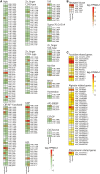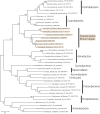A draft genome of the brown alga, Cladosiphon okamuranus, S-strain: a platform for future studies of 'mozuku' biology
- PMID: 27501718
- PMCID: PMC5144679
- DOI: 10.1093/dnares/dsw039
A draft genome of the brown alga, Cladosiphon okamuranus, S-strain: a platform for future studies of 'mozuku' biology
Abstract
The brown alga, Cladosiphon okamuranus (Okinawa mozuku), is economically one of the most important edible seaweeds, and is cultivated for market primarily in Okinawa, Japan. C. okamuranus constitutes a significant source of fucoidan, which has various physiological and biological activities. To facilitate studies of seaweed biology, we decoded the draft genome of C. okamuranus S-strain. The genome size of C. okamuranus was estimated as ∼140 Mbp, smaller than genomes of two other brown algae, Ectocarpus siliculosus and Saccharina japonica Sequencing with ∼100× coverage yielded an assembly of 541 scaffolds with N50 = 416 kbp. Together with transcriptomic data, we estimated that the C. okamuranus genome contains 13,640 protein-coding genes, approximately 94% of which have been confirmed with corresponding mRNAs. Comparisons with the E. siliculosus genome identified a set of C. okamuranus genes that encode enzymes involved in biosynthetic pathways for sulfated fucans and alginate biosynthesis. In addition, we identified C. okamuranus genes for enzymes involved in phlorotannin biosynthesis. The present decoding of the Cladosiphon okamuranus genome provides a platform for future studies of mozuku biology.
Keywords: Cladosiphon okamuranus; brown alga; genes for enzymes of polysaccharide synthesis; genome decoding.
© The Author 2016. Published by Oxford University Press on behalf of Kazusa DNA Research Institute.
Figures





Similar articles
-
Draft genome of the brown alga, Nemacystus decipiens, Onna-1 strain: Fusion of genes involved in the sulfated fucan biosynthesis pathway.Sci Rep. 2019 Mar 14;9(1):4607. doi: 10.1038/s41598-019-40955-2. Sci Rep. 2019. PMID: 30872679 Free PMC article.
-
Comparative genomics of four strains of the edible brown alga, Cladosiphon okamuranus.BMC Genomics. 2020 Jun 26;21(1):422. doi: 10.1186/s12864-020-06792-8. BMC Genomics. 2020. PMID: 32586267 Free PMC article.
-
Structural elucidation of fucoidan from Cladosiphon okamuranus (Okinawa mozuku).Food Chem. 2019 Jan 30;272:222-226. doi: 10.1016/j.foodchem.2018.08.034. Epub 2018 Aug 9. Food Chem. 2019. PMID: 30309536
-
Biosynthetic pathway and health benefits of fucoxanthin, an algae-specific xanthophyll in brown seaweeds.Int J Mol Sci. 2013 Jul 2;14(7):13763-81. doi: 10.3390/ijms140713763. Int J Mol Sci. 2013. PMID: 23820585 Free PMC article. Review.
-
Is the transformation of fucoidans in human body possible?Int J Biol Macromol. 2020 Jan 1;142:778-781. doi: 10.1016/j.ijbiomac.2019.10.018. Epub 2019 Oct 14. Int J Biol Macromol. 2020. PMID: 31622701 Review.
Cited by
-
A Genomics Resource for 12 Edible Seaweeds to Predict Seaweed-Secreted Peptides with Potential Anti-Cancer Function.Biology (Basel). 2022 Oct 4;11(10):1458. doi: 10.3390/biology11101458. Biology (Basel). 2022. PMID: 36290362 Free PMC article.
-
Genome-Scale Metabolic Networks Shed Light on the Carotenoid Biosynthesis Pathway in the Brown Algae Saccharina japonica and Cladosiphon okamuranus.Antioxidants (Basel). 2019 Nov 16;8(11):564. doi: 10.3390/antiox8110564. Antioxidants (Basel). 2019. PMID: 31744163 Free PMC article.
-
Identification, classification, and evolution of putative xylosyltransferases from algae.Protoplasma. 2019 Jul;256(4):1119-1132. doi: 10.1007/s00709-019-01358-2. Epub 2019 Apr 3. Protoplasma. 2019. PMID: 30941581
-
First Draft Genome Assembly of the Seaweed Sargassum fusiforme.Front Genet. 2020 Oct 23;11:590065. doi: 10.3389/fgene.2020.590065. eCollection 2020. Front Genet. 2020. PMID: 33193728 Free PMC article. No abstract available.
-
The draft genome of the tropical sea cucumber Stichopus monotuberculatus (Echinodermata, Stichopodidae) reveals critical genes in fucosylated chondroitin sulfates biosynthetic pathway.Front Genet. 2023 May 12;14:1182002. doi: 10.3389/fgene.2023.1182002. eCollection 2023. Front Genet. 2023. PMID: 37252657 Free PMC article. No abstract available.
References
-
- Adl S.M., Simpson A.G., Farmer M.A., et al. 2005, The new higher level classification of eukaryotes with emphasis on the taxonomy of protists. J. Eukaryot. Microbiol., 52, 399–451. - PubMed
-
- Keeling P.J. 2009, Chromalveolates and the evolution of plastids by secondary endosymbiosis. J Eukaryot. Microbiol., 56, 1–8. - PubMed
-
- Cavalier-Smith T. 1999, Principles of protein and lipid targeting in secondary symbiogenesis: euglenoid, dinoflagellate, and sporozoan plastid origins and the eukaryote family tree. J. Eukaryot. Microbiol., 46, 347–66. - PubMed
-
- Van Den Hoek C., Mann D.G., Jahns H.M. 1995, Algae: An Introduction to Phycology. Cambridge University Press, Cambridge.
-
- Yoshida T., Suzuki M., Yoshinaga K. 2015, Checklist of marine algae of Japan (revised in 2015). Jpn. J. Phycol (Sôrui)., 63, 129–89.
MeSH terms
Substances
LinkOut - more resources
Full Text Sources
Other Literature Sources
Molecular Biology Databases
Miscellaneous

